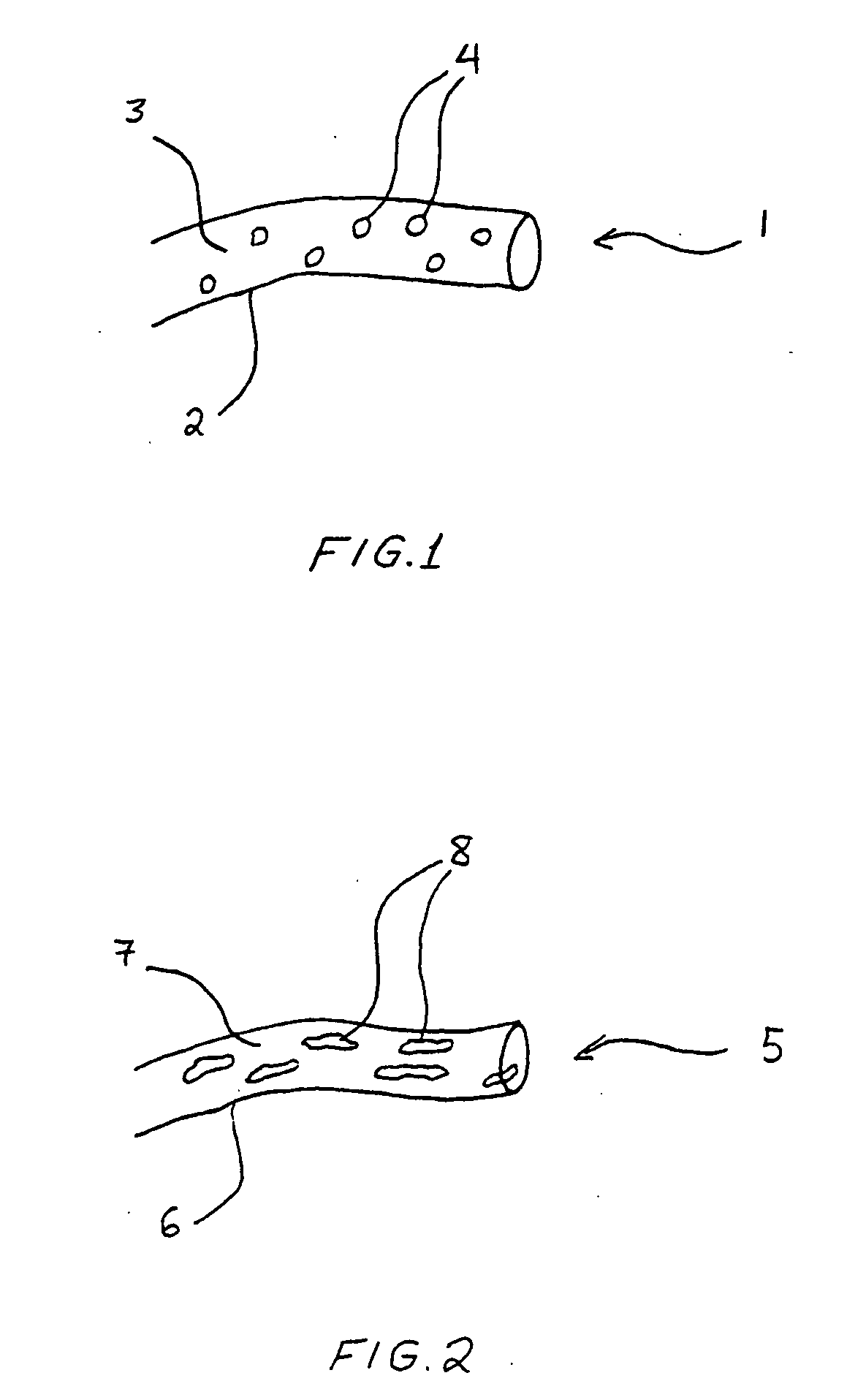Temperature regulating cellulosic fibers and applications thereof
a cellulosic fiber and temperature regulation technology, applied in the field of fibers, can solve the problems of non-woven fabrics generally failing to provide a desirable level of comfort, undesirable fabrics, and particularly undesirable fabrics
- Summary
- Abstract
- Description
- Claims
- Application Information
AI Technical Summary
Problems solved by technology
Method used
Image
Examples
example 1
[0117] Three sets of cellulosic fibers were formed. A first set of cellulosic fibers was used as a control set. For the first set of cellulosic fibers, 8.00 g of N-methyl morpholine oxide solvent (97 percent NMMO, available from Aldrich Chemical Co., Milwaukee, Wis.), 1.00 g of microcrystalline cellulose (available from Aldrich Chemical Co., Milwaukee, Wis.), and 1.00 g of deionized water were combined in a 20 ml glass vial to yield a solution with 10 percent by weight of cellulose. The vial was placed in a 125° C. oven and periodically mixed until its contents were homogenously mixed. The contents were then poured into a preheated 10 ml syringe and slowly squeezed into a coagulation bath of warm, stirred water to form the first set of cellulosic fibers.
[0118] For a second set of cellulosic fibers, 0.90 g of deionized water and 0.20 g of water-wetted microcapsules containing a phase change material (microencapsulated paraffin PCM, 120 J / g latent heat, 33° C. melting point, 50 perce...
example 2
[0121] A suspension was formed by adding in (with stirring) 100.0 kilograms of water and then 5.2 kilograms of a 50 percent NaOH / water solution to 100.0 kilograms of microcapsules containing a phase change material (mPCM, polyacrylic shell microcapsules containing octadecane, 175 J / g latent heat, 45 percent microcapsules, available from Ciba Specialty Chemical Co., Bradford, United Kingdom). The suspension contained 21.95 percent by weight of the microcapsules at a pH of about 12.8. The suspension was metered into a 9.1 percent cellulose solution to yield various sample sets with different mPCM concentrations, and then spun into cellulosic fibers as set forth in Table 5 below.
TABLE 5ConcentrationLatentLinearof mPCMHeatDensityTenacityElongation(%)(J / g)(decitex)(cN / tex)(%)Sample setA156.917.913.631.02101417.014.325.0357.74.315.219.141014.54.513.817.0557.21.817.915.2610141.517.413.1756.80.918.612.58810.70.917.011.6Sample setB1001.721.72021011.41.616.01332019.41.515.1134001.222.317510...
example 3
[0122] Two sets of viscose-type cellulosic fibers were formed. A first set of cellulosic fibers was used as a control set, and included TiO2 as a dulling agent. A second set of cellulosic fibers included microcapsules containing a phase change material (mPCM), but lacked TiO2. Table 6 sets forth properties of the two sets of cellulosic fibers. As can be appreciated with reference to Table 6, the second set of cellulosic fibers exhibited enhanced reversible thermal properties along with a dull appearance (without requiring the use of TiO2).
TABLE 6Amount ofAmountLinearStaple CutCellulosicmPCMof TiO2DensityLengthLatent HeatFibers(%)Appearance(%)(decitex)(mm)(J / g)First Set0.0Dull0.6-1.01.7400.0(Control Set)Second Set15.0Dull0.01.74013.2
[0123] Various non-woven fabrics were formed using either the second set of cellulosic fibers alone or as a blend along with standard viscose-type cellulosic fibers. The non-woven fabrics were formed using a standard viscose needlepunch non-woven line. ...
PUM
| Property | Measurement | Unit |
|---|---|---|
| Temperature | aaaaa | aaaaa |
| Temperature | aaaaa | aaaaa |
| Fraction | aaaaa | aaaaa |
Abstract
Description
Claims
Application Information
 Login to View More
Login to View More - R&D
- Intellectual Property
- Life Sciences
- Materials
- Tech Scout
- Unparalleled Data Quality
- Higher Quality Content
- 60% Fewer Hallucinations
Browse by: Latest US Patents, China's latest patents, Technical Efficacy Thesaurus, Application Domain, Technology Topic, Popular Technical Reports.
© 2025 PatSnap. All rights reserved.Legal|Privacy policy|Modern Slavery Act Transparency Statement|Sitemap|About US| Contact US: help@patsnap.com



